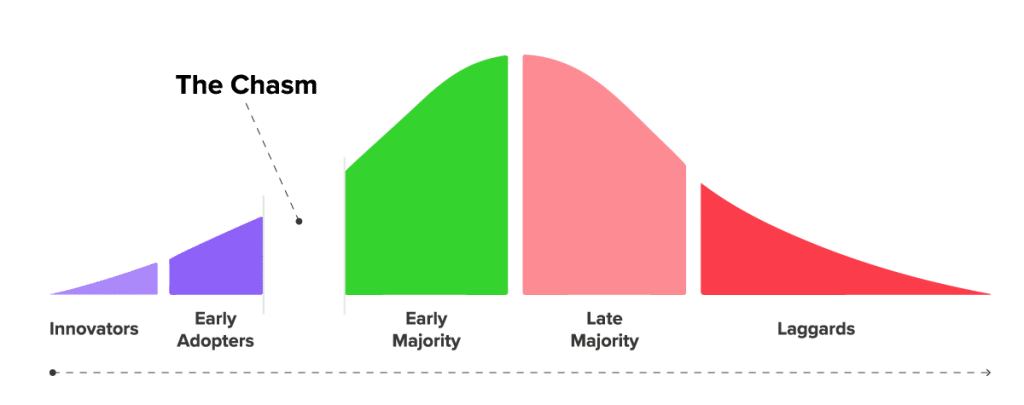Your team has spent months coming up with a marketing plan for that new product you’re launching.
There’s professional photography, killer content, and an awesome sales page that is sure to make anyone decide to buy without hesitation.
Then… nothing happens.
You’ve spent a huge chunk of your marketing budget on advertising, only to not see the results you were hoping for.
What do you do? The answer is product adoption.
In this guide, we’ll cover how this Digital Marketing concept can help you relate to your target market and make it easier for them to purchase.
Ready to get started? Let’s go.
- What is Product Adoption?
- What is the Product Adoption Curve?
- How to Measure Product Adoption
- Stages of the Product Adoption Process
- How to Increase Product Adoption
- Wrap Up: Selling More Products by Increasing Product Adoption
What is Product Adoption?
In a simple context, product adoption is the way potential customers hear about a product, buy the item, and then use it.
Yes, actually using the product is an important facet of product adoption.
Why?
When a customer adopts use in their daily lives, they’re much more likely to form an opinion of the item and the brand as a whole.
In the end, this translates to a better level of satisfaction and an improved customer journey process.
The product adoption concept based on type of item
Selling a monthly service and selling a tangible item are two different things.
That’s why it is important to look at product adoption from the right angle associated with what your company produces.
➤ For eCommerce brands, product adoption means ensuring that the item the customer purchases becomes their favorite or something they use on a regular or daily basis.
You want them to include the item in nearly every reasonable aspect of their day, making it more likely they would refer a friend or family member to your brand to purchase their own must-have piece.
➤ With service businesses, the process of product adoption means ensuring that your business is part of their normal routine.
Maybe that’s the delivery of a latte to the office each morning or someone who cuts their grass.
When the product you’re selling is a service, you want to ensure your customers never imagine life without the help of your team.
➤ In contrast, SaaS companies have to adjust product adoption to fit the provided solution.
Here, the process includes showing your ideal customer that your platform is a critical part of their workflow and how it is better than any other option on the market.
What is the Product Adoption Curve?
The truth is that most marketers believe that product adoption is a linear thing that happens when a new product is launched.
People find out about it, they make a purchase, and then they use the product or service.
In reality, the process is much more of what’s called a product adoption curve with multiple phases.
By understanding this curve, your team can adapt marketing messaging to where your ideal buyer is at within the process.
Here are the different groups of people in the curve:

Innovators
The innovators are the first ones to buy a new product.
Generally, they are somewhat familiar with your brand or had a hand in helping develop your new offering in some way.
Innovators are important for two key reasons.
First, they’re incredibly loyal. They generally feel a sense of pride in seeing an item become more popular or a brand grow, which means they’re more likely to early adopt your next release.
Second, they provide amazing feedback. Sending a survey out to an early product adopter is an excellent way to find areas of change for future improvements.
Early adopters
After those initial few innovators come early adopters.
These are those who aren’t afraid to try out a new product or service, but they are slightly less likely to be as loyal as the previous group.
However, they’re a good target market to try out new digital marketing tactics or strategies.
And they can provide excellent insight for what your company needs to do in terms of product education, positioning, and sales moving forward.
Early majority
Jumping from early adopters to early majority is usually no easy feat.
Once you’ve gotten to this stage, you’ve proven that your product is a good fit with your target market and you’re starting to see regular sales.
That’s why moving forward to this timeframe is so difficult.
It takes a ton of early adopters to work out the bugs to end up with a fair amount of early majority customers.
At this point, your product should be fairly well-known for the industry and have a regular following.
Case studies and testimonials are always a good marketing tactic during this phase.
Late majority
The late majority is really the second half of the early majority portion of the product adoption curve.
This is where you’re an industry leader and most people looking for the solution you provide know to check out your product first.
There’s no need to educate or persuade late majority customers.
They’ve already seen that others know it works, so they innately trust that your solution is right for their needs.
Laggards
Laggards are the very last people to adopt your product before you start to phase it out for something better.
They were probably skeptical at first, which is why they waited as long as possible to make a purchase.
In addition, they’re usually price-focused and looking for some sort of discount for waiting.
By this portion of the curve, you’ve likely already started product research for a better solution or have oversaturated the market to the point where it is time to refocus.
How to Measure Product Adoption
After companies start to utilize a product adoption process, they likely want to learn about ways to measure their progress.
➤ While it isn’t always easy to accomplish, it is possible to determine where you’re at in the curve based on:
- What your users are doing.
- And how well sales are going.
➤ Customer feedback can also be a prime indicator of product adoption.
Sending out surveys in exchange for a discount or even just asking customers to leave testimonials can be an excellent method for gauging market attitude.
➤ Checking in on your customer service team can be an indicator of product adoption, too.
Track what questions or comments keep coming up often to determine where there might be cracks in your education or communication process.
By making changes according to need, you’re much more likely to see better growth moving forwards.
Stages of the Product Adoption Process
Unlike the product adoption curve, the stages of the process typically happen in a more linear fashion.
However, you can have buyers at different levels of the process at any time as they go through individual customer journeys.
The main factor to remember is that you have campaigns in place for each step of the product adoption process.
1. Awareness & Introduction
During the awareness and introduction phase, customers are just finding out about your product.
This is a time when you’re likely using digital marketing and paid advertising to try to draw attention to what you’re selling.
Buyers don’t have any serious knowledge about your product other than it exists.
They might be curious, which is why it is good to use education as a way to move them along to the next step.
2. Interest & Information gathering
During the interest and information gathering process, your customers know about your product and are willing to learn more.
They might read the product descriptions on your website, check a few reviews, or watch a demonstration video.
This is when they aren’t yet willing to buy, but they have a significant curiosity about the product and are willing to do a bit of research to find out if it meets their needs.
3. Evaluation & Comparison
During the evaluation and comparison step of the product adoption process, customers are reviewing the information they’ve gathered and sizing it up against what is already on the market.
They’re extremely interested in making a purchase at this point and have likely made up their mind in some manner.
However, this is often the part where you can lose their attention.
That means it is incredibly important to use follow-up tactics like abandoned cart emails, reminders, follow-up phone calls, or whatever else makes sense for your platform and niche.
4. Trial
Finally, there’s the trial step in the product adoption process.
Now is when they’ve made the purchase and are using your product for a short period of time.
In addition, they’re likely making judgments or forming opinions about likes and dislikes.
They might give additional feedback in the form of surveys or testimonials. And they’re still trying to decide if using your product long-term is a good idea.
5. Adoption or Rejection
Finally, there’s the adoption or rejection phase of the process.
This is where the customer either likes or dislikes the product.
Product adoption means they’ll continue to use the item or service for an extended period of time.
Rejection means they won’t, which can equal a return, cancellation, or just chucking a physical item straight into a closet or trash can to never be seen again.
Every brand has customers in each camp, so it isn’t something to feel bad about.
Remember: your product can’t solve everyone’s problems all of the time. The key is to try to get as many people as possible into the adoption category.
How to Increase Product Adoption
So, how do you ensure more people adopt your product than reject it?
By using a few key product adoption tactics, of course!
Create an excellent onboarding process
While this doesn’t apply as much to those creating tangible products, having an excellent onboarding process is a great way to help new customers get acquainted with your product more quickly.
Often, education as part of this process can mean they’re more comfortable with various features or benefits.
This generally leads to a better adoption process and overall positive perception of the product.
Plus, it can help keep customer service or support requests to a minimum, as buyers will have a resource to turn to when they have specific questions regarding the product.
Place a high emphasis on customer service
In general, companies that receive a lot of complaints about new products aren’t using a wider adoption strategy.
After all, if you’re giving buyers the information they need upfront and producing a quality product or service that fits their needs, they aren’t going to have customer service requests.
However, taking a firm stance on always providing the best response possible is paramount to your success.
Brands are built and die on their reputation for helping customers, so it is absolutely imperative that you work to ensure yours is a positive one.
Make a better product than your competitors
While this should always be a pretty clear goal, one way to improve product adoption is to always create a better item than what your competition offers.
After all, people looking for value will see that you’re offering a better fit to their needs and choose your brand first.
To do this, you should get to know your buyer persona clearly and understand all the varying factors that play into their needs.
Make a list and check them off during product development to ensure your product truly stands out within the marketplace.
Give customers a reason to engage
To improve product adoption, you should also give customers a reason to continue to engage with your brand long after their purchase.
For example, maybe you run a contest each month on social media where users must submit a photo of themselves using your product.
Or you offer a discount for those that sign up for your weekly email list or share a referral code with a friend.
A major part of product adoption is liking the item or service well enough to share it with others, which is why this type of encouragement is always a good idea.
Make improvements along the way
A funny thing happens when companies start taking a product adoption focus.
They get tons of great feedback from customers. Both solicited and unsolicited.
For most brands, this is a really good thing.
Not only does it give further insight to the needs of your target market, but it also provides information on where improvements are necessary.
That’s when you can take this data and make changes based on what the customer wants — not what your team thinks they need.
Use education to prevent fear and uncertainty
Most consumers don’t like change.
They know they need a solution to a specific problem, but they aren’t always willing to take the leap.
That’s where a great education process prior to purchase can be a big deal.
Using varying media methods and platforms for video, written content, audio content, and more can be an excellent way to help move them through the product adoption curve and make informed decisions about your product.
In fact, this is a great spot for using influencer marketing and other trust-based digital marketing tactics to help spread the word about what your service or tangible item can do.
Wrap Up: Selling More Products by Increasing Product Adoption
Long gone are the days of blindly selling a new product or service and hoping for the best.
Today, it is more important than ever to consider the overall buyer journey and how your brand is perceived in the market.
By utilizing a product adoption strategy, you can help ensure your customers not only love what you offer but are loyal followers for an extended period of time.
And don’t worry if your product is a little more complex than most.
In this blog post, we give you 8 tips on how to sell products that aren’t really straightforward!











